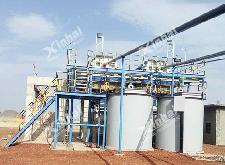

Warm Tip: If you want to know more details about equipment, solutions, etc, please click the button below for free consultation, or leave your requirements!
Silver extraction process varies due to the different properties of silver ore. There are many kinds of silver minerals in the nature, among which those with production value include native silver, kustelite, phyargyrite, horn silver, dyscrasite and so on. Silver is often associated with lead-zinc ore, copper ore, gold ore, limonite and can be recovered with other minerals. In the following, we will start with the mineral properties of silver ore and take you to understand the silver extraction process.
Silver in silver-bearing minerals has fine grain size and complex occurrence state. Therefore, grinding is very important in the preparation stage of the silver extraction process. Due to the complex composition of the silver-bearing minerals, the silver extraction methods are diverse, including flotation, cyanidation, flotation - cyanidation, gravity - flotation and so on. In the following, we will introduce silver extraction process from the preparation stage and the separation stage.

Grinding during the preparation stage has a great impact on the extraction of silver ore. And the grinding section number and grinding fineness need to be determined according to the dissemination characteristics and occurrence state of silver ore. The crystal size of silver minerals is mostly between 5-10μm, and the main carrier particle size is much coarser than the silver mineral itself. Therefore, it is not necessary to achieve the degree of dissociation of all the monomers of the silver mineral in the grinding stage, and the carrier can be sufficiently dissociated. But this situation is under ideal conditions. In addition to some silver minerals with copper, lead, zinc and other minerals as carriers, some silver minerals are dispersed in gangue minerals in irregular forms, or silver minerals are embedded in fine grains, while other sulfide minerals have lower content. For these two types of silver extraction, the monomer dissociation of fine-grained silver minerals can be achieved by increasing the fine grinding stage.
In the silver extraction process, flotation is a method commonly used to extract silver and its associated metals. According to the different ore characteristics, the flotation process includes priority flotation, mixed flotation, partial priority flotation, partial mixed flotation, asynchronous flotation, staged flotation, isoflotability flotation, branch stream flotation, and so on. In silver extraction process, it is necessary to pay attention to the pH value of the pulp and the combination of reagents.
In the silver flotation process, it is necessary to avoid the use of some regulators, for example, lime, cyanide can inhibit the silver mineral. When using regulators such as sodium sulfite, sodium sulfate, and starch, attention should be paid to their dosages. If the amount is too large, it is not good for the silver extraction process. The suitable pulp pH value of silver flotation is 6 to 8. In actual production, it should also be adjusted according to the recovery of other minerals.
In addition to the mesh of grinding and pH value of the pulp, a suitable chemical system is a key factor affecting the silver extraction process. The main collectors of silver and its carrier metal sulfide minerals include ammonium dibutyl dithiophosphate, dianilinodithiophosphoric acid, sodium ethylxanthate, sodium butylxanthate, ethyl thio carbamate, thionocarbamates, etc. Using mixed collectors on the basis of single collector can enhance the collect effect of flotation. Common collector combinations include ammonium dibutyl dithiophosphate and xanthate, dianilinodithiophosphoric acid and xanthate.
The cyanidation method is suitable for silver extraction from ore with coexisting gold and silver. It is also suitable for the silver extraction where silver mineral is fine grain embedded, quartz is the main gangue mineral and the content of sulfide is low. The leachable silver minerals include silver oxide, elemental silver and silver sulfide. The principle is to use cyanide to dissolve the silver mineral in the pregnant solution, and then use the zinc replacement method to complete the silver extraction process. At this stage, the factors that can affect the silver extraction include the amount of sodium cyanide, the amount of oxygen, the amount of leaching aid, and the leaching time.
The combined gravity-flotation process is suitable for silver ores with high grade but uneven particle size and easy to dissociate, which can improve the recovery rate of silver and reduce the processing cost. The combined flotation-cyanidation process is suitable for the recovery of silver minerals embedded in gangue minerals, which can improve the recovery rate of silver.
The above introduced some knowledge of silver extraction process. Flotation, cyanidation, flotation-cyanidation, gravity-flotation process are all silver extraction processes commonly used in silver extraction plants. In actual production, an appropriate silver extraction method should be formulated according to characteristic of the ore and processing test.
Last: Ultimate Guide of Gold Heap Leaching Process
Next: Impact Crusher VS Jaw Crusher:What Are the Differences?


What Are the Differences Between CIP and CIL?
 11482
11482
 0
0